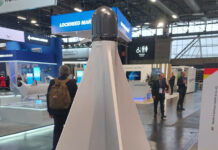
RADA Electronic Industries announced today its RPS-42 radar system has been selected by a country in the Far East to be used in the development and evaluation of High-Energy Laser (HEL) weapon system. The announcement follows the the selection of these Israel’s radar for similar programs in North America and Europe.
The RPS-42 is a member of the Multi-Mission Hemispheric Radar (MHR) family of tactical land radars used for force and border protection. Evolving tactical weapon system, directed energy weapons such as HEL are positioned to become the next generation of close-range air defense weapons, offering additional use against mortars, rockets and missiles as well as drones ground-based tactical weapon system. Compact, yet powerful and agile, the RPS-42 provides an excellent sensor for such applications, particularly in mobility and autonomy, enabling unique operation on the move capability for the weapon system.
The current order is the fourth application of MHR for HEL weapon systems. The MHR is currently integrated into the US Navy/Marine Corps GBAD HEL program, the Lockheed Martin Athena HEL program, and Boeing’s HEL-MD and Silent Strike programs.
“The high energy laser market is gradually being recognized as the weapon for the future, and we are very happy to be involved in a continuously growing number of such programs.” said Dov Sela, RADA president and CEO.

“There are about ten HEL development programs in the Western world; and we are currently involved in four such programs, as well as being in advanced discussions with additional four integrators in the Far East, Europe and the USA. This current order is the fourth order of MHR for HEL weapon systems, re-emphasizing the suitability and potential of the MHR to this application” Sela added.
Ground-Based tactical HEL systems are widely perceived today as the weapon of the future. This is because they are able to produce precise and tailored effects against multiple targets, they support ‘speed-of-light’ responsiveness and have deep magazines. These disruptive capabilities allow them to support a wide range of missions and create military technology ‘breakout’. Moreover, their significant lower cost per shot compared to expendable kinetic munitions, has the potential to change the economics of war. Typically, such weapons would be used against tactical, low-cost and short-range threats, which endanger the maneuver force, such as rockets, mortars (C-RAM mission) and UAVs (C-UAV mission).



















